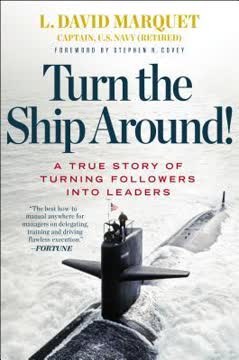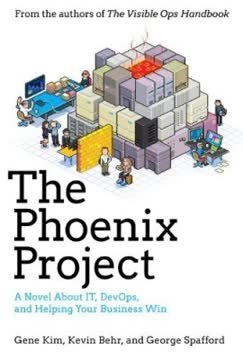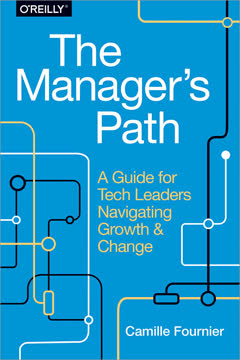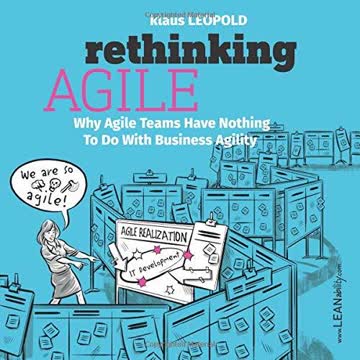Key Takeaways
1. Agile Transformations Often Miss the Mark
Often, though, Agile odysseys start with this local (sub-)optimization, where at the same time their chosen agile method becomes the golden calf.
Misguided focus. Many companies embark on agile transformations with good intentions, committing resources and training, yet fail to achieve their core goals like faster time-to-market. This often stems from a fundamental misunderstanding: they focus on implementing agile methods at the team level, rather than addressing systemic issues that hinder overall business agility. The transformation becomes about "doing Agile" correctly, not about "being agile" to deliver customer value.
Symptoms of failure. Despite significant investment in training, coaching, and reorganizing into cross-functional teams, key metrics like throughput and cycle time at the organizational level often stagnate or even worsen. Projects take longer to complete than before the transformation, leading to frustration and questioning the entire agile initiative. This indicates that optimizing isolated parts of the system, like individual teams, does not automatically improve the performance of the whole.
The core problem. The initial goals—optimizing time-to-market, faster customer feedback, and future readiness—are forgotten as the organization gets bogged down in dogmatic discussions about agile rules and roles. The means (agile methods) become the purpose, diverting attention from the actual business objectives and the customer, who ultimately pays the bills.
2. Local Optimization Kills Global Agility
The performance of the whole is never the sum of the parts taken separately, but it´s the product of their interactions.
Sub-optimization trap. A common pitfall in agile transformations is the belief that optimizing individual teams will automatically lead to an optimized overall system. This is a fallacy of simplistic inference. Even if a team becomes incredibly fast and efficient, its impact on the entire value chain is limited if it's constantly waiting on other teams or upstream processes.
The keyboard analogy. Imagine a company where each team is responsible for a single letter on a keyboard. Even if you have the "fastest 'F'-team on the planet," the overall correspondence (the customer's desired outcome) won't be finished faster if the flow of letters between teams is unmanaged. The speed of individual parts doesn't matter if the interactions between them are slow or chaotic.
Systemic thinking. True agility comes from optimizing the interactions between teams and across the entire value stream, not just the performance of isolated units. If an organization wants to increase its system output, it must ensure that the right team is working on the right thing at the right time, which requires managing dependencies and understanding the holistic flow of work.
3. Manage Dependencies Across the Entire Value Stream
There should be as many dependencies eliminated as possible. Most important, though, is good management of every dependency which remains.
Dependencies are inevitable. While the goal of cross-functional teams is to reduce dependencies, it's unrealistic to eliminate all of them in complex knowledge work organizations. Products often require multiple teams, and products themselves can be interdependent. The challenge isn't to eradicate dependencies, but to manage them effectively.
Making dependencies visible. The first step is to visualize these interactions. Product boards (Flight Level 2) can be created to show how different teams collaborate on a single product, making intra-product dependencies clear. For dependencies between products (inter-product dependencies), an operational portfolio board can bring multiple product value streams together.
Active management through feedback loops. Visualization alone is insufficient; active management is key. This involves:
- Product Standup Meetings: Regular, short meetings with team delegates to coordinate workflow across the product.
- Replenishment Meetings: Deciding collectively which work enters the system next, considering WIP limits and priorities.
- Cross-team Retrospectives: Regularly reviewing collaborative delivery to identify and implement improvements across teams.
These feedback loops ensure continuous coordination and problem-solving at the value stream level.
4. WIP Limits Must Apply at the Strategic Level
You must limit the work where you want the effect, the value and the benefits of WIP limits to be realized.
The WIP paradox. Many agile teams diligently apply Work in Process (WIP) limits to their tasks and user stories, yet the overall organization's time-to-market doesn't improve. This is because the critical WIP limits are missing at the strategic level, where projects and initiatives are started. Management often mistakenly believes that "agile teams" mean they can start more projects, leading to system overload.
Little's Law in action. The fundamental principle of Little's Law states: Average Cycle Time = Average WIP / Average Throughput. This means that if the number of initiatives (WIP) in the system increases without a proportional increase in completion rate (throughput), the average time to complete any initiative (cycle time) will inevitably increase. It's like an airport where more planes are landing than taking off – eventually, nothing moves.
Strategic WIP is crucial. To truly improve time-to-market, the number of initiatives or projects in the entire organizational system must be limited. This responsibility falls to strategic portfolio management. By limiting the number of concurrent strategic initiatives, the organization can focus its efforts, reduce context switching, and ensure that work is actually completed and delivered, not just started.
5. Integrate the Full End-to-End Value Stream
Business agility is created through lean processes that rapidly implement ideas, thus allowing teams to be able to deliver something quickly.
Beyond development. Business agility isn't achieved by making only the development department agile. The entire value stream, from initial idea generation and decision-making (upstream) to integration, acceptance testing, and release (downstream), must be optimized. If agile development teams are stuck waiting months for approvals or quarterly releases, their local agility is rendered useless.
Eliminating time traps. Upstream processes often contain significant time traps:
- Annual Budget Cycles: Planning for a year in advance kills responsiveness. Decisions should be made frequently, aligning with desired business agility (e.g., monthly replenishment).
- "Colleagues as Suppliers": Treating internal departments like external vendors, with lengthy estimation and approval processes, creates unnecessary friction and delays.
- Over-estimation: Spending excessive time estimating work that is legally required or strategically vital, regardless of cost, is wasteful. Estimates should be "just exact enough" for decision-making.
Streamlined flow. The goal is to create a fast, steady workflow from idea to delivered value. This means simplifying preliminary processes, making decisions more frequently (e.g., bi-weekly concept approvals), and fostering continuous collaboration between business and development, rather than maintaining a rigid "us vs. them" dynamic.
6. Strategic Portfolio Management is the True Starting Point
If the possibility exists to start an agile transformation at Flight Level 3, you should do it. Because the only agile team that you absolutely need at the beginning of an agile transformation or change initiative is an agile upper-management team that practices agile strategic portfolio management.
Top-down alignment. Business agility fundamentally requires strategic direction and management from the top. Upper management is responsible for setting the strategic course and ensuring that all work aligns with it. Without an agile leadership team, any transformation efforts at lower levels will eventually hit a ceiling.
The Strategy Board. A Strategy Board (Flight Level 3) visualizes all current and planned projects and initiatives, linking them directly to the company's strategic goals and key business metrics. This transparency allows for collective, informed decision-making, moving away from isolated approvals. It helps answer critical questions like:
- How much work can the organization truly sustain?
- Is the work aligned with our strategy?
- When can a new project be started, given current WIP?
Continuous strategic alignment. Just like other levels, strategic portfolio management needs continuous feedback loops:
- Strategic Portfolio Standups: Frequent (e.g., weekly) meetings where upper management and delegates review progress, make timely decisions, and ensure strategic alignment.
- Strategic Retrospectives: Monthly reviews to improve collaboration and the strategic process itself.
- Strategy Reviews: Quarterly assessments of market changes, competition, and whether the overall strategy needs correction. This ensures the organization is always working on the right things.
7. Business Agility is a Company Sport, Not a Team Sport
Business agility is not a team sport—it is a company sport!
Holistic transformation. The core message is that true business agility cannot be achieved by simply making individual teams or departments "agile." It requires a fundamental shift in how the entire organization operates, from strategic decision-making down to daily operations, and across all functional areas.
Interconnectedness. The Flight Levels model (Operational, Coordination, Strategic Portfolio) illustrates this interconnectedness. Each level has a distinct focus, but they must communicate and collaborate seamlessly.
- Flight Level 1 (Operational): Teams doing the daily work.
- Flight Level 2 (Coordination): Optimizing interactions and flow between teams for a product or value stream.
- Flight Level 3 (Strategic Portfolio): Aligning all work with company strategy and managing the overall flow of initiatives.
Leverage points. The higher the Flight Level, the greater the potential leveraging effect for overall organizational improvement. While teams can optimize locally, systemic change requires addressing issues at the coordination and strategic levels, where dependencies and overall flow are managed.
8. Focus on Outcome, Not Just Output
Ultimately, the goal of business agility is to positively impact the business metrics. It´s great if you deliver eight percent more features – but if nobody needs them, you have eight percent more garbage.
Value over volume. A common trap in agile transformations is to measure success by the quantity of features delivered (output) rather than the actual business value created (outcome). Delivering more features faster is meaningless if those features don't solve customer problems, generate revenue, or advance strategic goals.
Measuring true impact. Companies should quantify the "Cost of Delay" to understand the financial impact of late product releases. Metrics should shift from tracking team velocity or story points to measuring how initiatives impact key business figures like revenue, profit, and market share. For example, a project is only "finished" on the strategy board when it has achieved its intended market result.
Experimentation and feedback. True outcome focus encourages a culture of experimentation. Ideas are implemented quickly enough to gather real customer feedback, allowing for rapid adjustments. This iterative approach ensures that resources are not wasted on initiatives that fail to deliver desired results, fostering a learning organization.
9. The Agile Transformation Itself Must Be Agile
If the desired state is agility, the way there should already be agile.
Practice what you preach. It's ironic and ineffective to manage an "agile transformation" using a rigid, traditional waterfall project plan with fixed milestones and checklists. If the goal is to become flexible and adaptable, the process of change itself must embody these principles.
Pull, not push. Instead of forcing new methods onto employees (push principle), the transformation should leverage the pull principle. Teams should be empowered to choose methods that fit their context, and changes should be "pulled" by the organization as needs arise, rather than being dictated by a fixed schedule.
Continuous adaptation. An agile transformation is not a one-time project with a defined end date. It's a continuous journey of learning and adaptation. The organization should constantly inspect its progress, identify new challenges, and evolve its approach, just as agile teams do in their retrospectives. This mindset prevents the transformation from becoming a static, bureaucratic exercise.
10. Cross-Functionality is a Company Mentality
Cross-functionality is a company mentality and not an organizational setup for teams. It means creating an environment where it is ok, or even desired, to perform poorly locally (whilst learning) if it helps the overall performance of the organization.
Beyond team structure. While cross-functional teams are a good start, true cross-functionality extends beyond team composition. It's a cultural shift where the entire organization breaks down silos and fosters collaboration across departments (e.g., business, IT, HR, legal). Without this broader mentality, functional silos can simply be replaced by "cross-functional silos."
Shared purpose. The goal is to move from an "us vs. them" mentality, where departments act as internal suppliers, to a cohesive "we" that works together towards a common customer-centric goal. This requires:
- Recruitment: Prioritizing "attitude" over just "skills" to build a collaborative workforce.
- Performance Metrics: Shifting from individual or departmental performance bonuses that foster internal competition to metrics that reward integrated value delivery.
- Psychological Safety: Creating an environment where it's safe to experiment, fail, and learn, even if it means temporary local underperformance for the greater good of the organization.
Integrated value generation. When all parts of the organization understand and contribute to the end-to-end value stream, true business agility emerges. This means everyone pulling in the same direction, focusing on the customer, and continuously improving the collective process, not just their isolated piece of it.
Last updated:
Review Summary
Rethinking Agile receives positive reviews for its insights on business agility. Readers appreciate the book's focus on optimizing entire value streams rather than just individual teams. The case study format and visual presentation make complex concepts accessible. Many reviewers highlight the book's emphasis on management involvement and the importance of looking beyond traditional agile methods. Some criticize the lack of new information or practical examples. Overall, readers find it a valuable resource for understanding and implementing true business agility.
Similar Books










Download PDF
Download EPUB
.epub digital book format is ideal for reading ebooks on phones, tablets, and e-readers.





